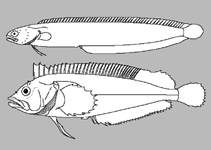Heteroclinus perspicillatus (Valenciennes, 1836)
Common weedfish
Add your observation in Fish Watcher
| Native range |

|
| This map was computer-generated and has not yet been reviewed. |
| Heteroclinus perspicillatus AquaMaps Data sources: GBIF OBIS |
Upload your photos and videos
Google imageNo image available for this species;
drawing shows typical species in Clinidae.
Google imageNo image available for this species;
drawing shows typical species in Clinidae.
Classification / Names Nomi Comuni | Sinonimi | Catalog of Fishes(Genere, Specie) | ITIS | CoL | WoRMS | Cloffa
> Blenniiformes (Blennies) > Clinidae (Clinids)
Etymology: Heteroclinus: Greek, heteros = other + Greek, klinein, kline = sloping and bed, due to the four apophyses of sphenoid bone (Ref. 45335).
More on author: Valenciennes.
Etymology: Heteroclinus: Greek, heteros = other + Greek, klinein, kline = sloping and bed, due to the four apophyses of sphenoid bone (Ref. 45335).
More on author: Valenciennes.
Environment: milieu / climate zone / depth range / distribution range Ecologia
marino associati a barriera corallina. Temperate
Distribuzione Stati | Aree FAO | Ecosystems | Presenze | Point map | Introduzioni | Faunafri
Eastern Indian Ocean: southern Australia.
Size / Peso / Age
Short description Chiavi di identificazione | Morfologia | Morfometria
Spine dorsali (totale) : 34 - 37; Raggi dorsali molli (totale) : 3 - 5; Spine anali: 2; Raggi anali molli: 22 - 26. Pelvic fin rays thick, finger-like (Ref. 9002). Usually greyish or greenish, large dark blotches arranged in vertical bands; usually a distinct shoulder spot (Ref. 9002).
Body shape (shape guide): elongated.
Body shape (shape guide): elongated.
inhabits rocky reefs, on sand with sparse algae growth or weeds (Ref. 9002). Often under rocks (Ref. 9002).
Life cycle and mating behavior Maturità | Riproduzione | Deposizione | Uova | Fecundity | Larve
Main reference
Upload your references | Bibliografia | Coordinatore : Williams, Jeffrey T. | Collaboratori
Kuiter, R.H., 1993. Coastal fishes of south-eastern Australia. University of Hawaii Press. Honolulu, Hawaii. 437 p. (Ref. 9002)
CITES
Not Evaluated
Threat to humans
Harmless
Human uses
FAO - Publication: search | FishSource |
Informazioni ulteriori
Population dynamics
Growth parameters
Max. ages / sizes
Length-weight rel.
Length-length rel.
Length-frequencies
Mass conversion
Reclutamento
Abbondanza
Growth parameters
Max. ages / sizes
Length-weight rel.
Length-length rel.
Length-frequencies
Mass conversion
Reclutamento
Abbondanza
Life cycle
Riproduzione
Maturità
Maturity/Gills rel.
Fecundity
Deposizione
Spawning aggregations
Uova
Egg development
Larve
Dinamica popolazioni larvali
Riproduzione
Maturità
Maturity/Gills rel.
Fecundity
Deposizione
Spawning aggregations
Uova
Egg development
Larve
Dinamica popolazioni larvali
Anatomy
Area branchiale
Brain
Otolith
Area branchiale
Brain
Otolith
Physiology
Body composition
Nutrients
Oxygen consumption
Swimming type
Swimming speed
Visual pigments
Fish sound
Diseases & Parasites
Toxicity (LC50s)
Body composition
Nutrients
Oxygen consumption
Swimming type
Swimming speed
Visual pigments
Fish sound
Diseases & Parasites
Toxicity (LC50s)
Genetics
Genetica
Heterozygosity
Ereditarietà
Genetica
Heterozygosity
Ereditarietà
Human related
Aquaculture systems
Profili di acquacoltura
Varietà
Ciguatera cases
Stamps, coins, misc.
Aquaculture systems
Profili di acquacoltura
Varietà
Ciguatera cases
Stamps, coins, misc.
Strumenti
E-book | Giuda pratica | Generatore frequenze di lunghezza | Strumento Parametri Biologici | Mappa dei ritrovamenti | Classification Tree
| Catch-MSY |
Special reports
Download XML
Fonti Internet
AFORO (otoliths) | Aquatic Commons | BHL | Cloffa | BOLDSystems | Websites from users | Check FishWatcher | CISTI | Catalog of Fishes: Genere, Specie | DiscoverLife | ECOTOX | FAO - Publication: search | Faunafri | Fishipedia | Fishtrace | GenBank: genome, nucleotide | GloBI | Google Books | Google Scholar | Google | IGFA World Record | MitoFish | Otolith Atlas of Taiwan Fishes | PubMed | Reef Life Survey | Socotra Atlas | Tree of Life | Wikipedia: Go, ricerca | World Records Freshwater Fishing | Zoological Record
Estimates based on models
Preferred temperature (Ref. 123201): 14.3 - 18.3, mean 16.8 °C (based on 182 cells).
Phylogenetic diversity index (Ref. 82804): PD50 = 0.5000 [Uniqueness, from 0.5 = low to 2.0 = high].
Bayesian length-weight: a=0.00513 (0.00223 - 0.01182), b=3.06 (2.86 - 3.26), in cm total length, based on LWR estimates for this (Sub)family-body shape (Ref. 93245).
Trophic level (Ref. 69278): 3.5 ±0.5 se; based on diet studies.
Resilienza (Ref. 120179): Alto, tempo minimo di raddoppiamento della popolazione meno di 15 mesi (Preliminary K or Fecundity.).
Fishing Vulnerability (Ref. 59153): Low vulnerability (10 of 100).
Nutrients (Ref. 124155): Calcium = 31.2 [11.5, 54.3] mg/100g; Iron = 0.24 [0.12, 0.43] mg/100g; Protein = 18.8 [17.6, 19.9] %; Omega3 = 0.229 [0.110, 0.456] g/100g; Selenium = 6.59 [2.55, 15.65] μg/100g; VitaminA = 66.4 [16.0, 284.6] μg/100g; Zinc = 0.837 [0.515, 1.341] mg/100g (wet weight);




